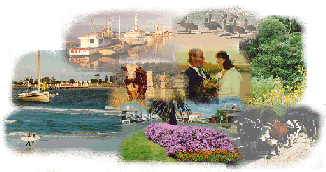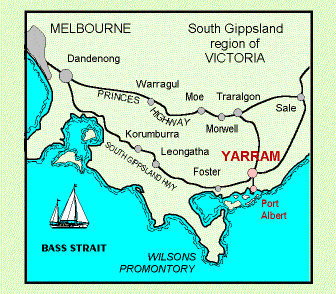TOORA WIND FARM
Controversial, intrusive, ineffective, community-disruptive,
but fascinating to some as a tourist attraction. Why I have no idea, but
to the occasional visitor seeing them for the first time, they are awesome
as some children will comment. But try to live with them! What may have
been accepted as an effective alternative source of energy has turned into
a nightmare for many people. This however does not detract from Toora as
being a small but delightful town with a number of interesting shops and
cafes. Only twenty minutes by car from Yarram west toward Melbourne on
the South Gippsland Highway.
TARRA-BULGA NATIONAL PARK
Victoria is blessed with many superb National
parks, but none so beautiful and intimate as that in the Tarra Valley,
only fifteen minutes by car from Yarram. Superb Mountain Ash and Mrytle
Beech provide a cool and sheltered environment for ferns and birdlife.
Clearwater streams amble through the two parks, with a waterful and swing
bring over a deep fern gully adding to the attractions. The walks are short
and comfortable. There is nothing nicer than a picnic in the park be it
to shelter during the heat of summer, or to enjoy the crispness of the
air in winter.
Access: From Yarram via Devon North, or from
Traralgon.
Facilities: Caravan parks (outside the National
Park boundary), tea-rooms (at Balook), picnic areas, sheltered bar-b-ques,
nursery and crafts (at Eilean Donan), self-contained period home accommodation
(at Eilean Donan).
The Visitors centre is open from 10.00am-4.00pm
during Victorian school holidays, weekends, and public holidays, except
Christmas Day.
NINETY MILE BEACH
The western end of the Ninety-Mile Beach is only
twenty minutes by car from Yarram. Rarely crowded, the beach offers surfing,
fishing and swimming. The beach is patrolled on weekends and holidays for
safer swimming.
Access: South from Wodside on the South Gippsland
Highway between Yarram and Sale, or along Pound Road East off the South
Gippsland highway just south of Yarram.
Facilities: Caravan park, kiosk, picnic area.
FISHING VILLAGES
Apart from Port Albert, which is a must to visit,
there are a number of small hamlets that allow access to the open sea or
inlets, ideal for fishing, boating and relaxing. These include Robertsons
Beach, Manns Beach, and McLoughlins Beach.
Access: Via Yarram or Woodside.
Facilities: Boat ramps at Manns Beach and McLoughlins
Beach.
HIAWATHA
There are many superb scenic drives through the
hills to the north and west of Yarram. The countryside is always green
and undulating, with pastured fields in the rich diary country, or rolling
hills of natural timber, or pine forests. One of the finest drives is to
a beautiful place called Hiawatha, perhaps rather incongruously named,
but it does have the Minne Ha Ha falls. This is a quiet picnic area tucked
away at the foot of the hills to the west of Yarram, a great place for
the family to relax and play.
Access: From Yarram via Church Road opposite
the Hospital.
Facilities: Camping is permitted. Sheltered bar-b-que,
toilets.
FORESTS AND WALKS
Apart from the Tara-Bulga national Park, there
are a number of other interesting parks and walks in the area. A pleasant
walk extends between Seabank Caravan Park and Port Albert along the Old
Port waterway. White Woman's Waterhole has an interesting legend attached
to it, and is also provides a walking track through natural bush of grey
gums and banksia. Access is along Napier Road at Won Wron just north of
Yarram. The Alberton West State Forest provides excellent bushwalking tracks
- obtain a map from the shire's office in Yaram, or the Department of Conservation
and Natural Resources in Yarram.
WILSONS PROMONTORY
One of the most magnificent national parks in
Australia, Wilsons Promontory is less than an hour drive west of Yarram.
This stunning area offers superb walks, safe beaches for swimming and srolling,
and beautiful views across to the islands. You can even see Tasmania from
here. The Prom is an easy day trip from Yarram. Nearby Waratah Bay is also
worth a visit. There are so many attractions in the region that they warrant
a page for themselves.
GRAND RIDGE ROAD
This magnificent mainly gravel road stretches
for 165 kiometres from the South Gippsland Highway at Lang Lang to the
Hyland Highway which connects Yarram and Traralgon. It is a magnificent
tourist drive, with superb scenery. It was once studded with guest houses
as holidaymakers came from Melbourne in their wooden-spoked wheel vehicles,
but now only the tarra-Bulga Guest House, built in 1934, remains, at Balook.
There are many places to stop and admire the view, with the tarra-Bulga
National Park being a highlight.
AGNES FALLS
About a half hour drive from Yarram, the Agnes
River drops sixty metres creating a beautiful drop over many stone ledges.
The surrounding grounds are well kept as a public picnic area - a delightful
place for lunch. Access is from Welshpool; take the road opposite the primary
school. The falls are well signposted.
FORESTS
Apart from the tarra-Bulga National Park, there
are a number of interesting natural forests in the region. The BOODYARN
STATE FOREST is only twenty minutes from Yarram, along Napier Road at Won
Wron (off the Hyland Highway). A picnic area within the forest, at WHITE
WOMAN'S WATERHOLE, is a delightful spot. The ALBERTON WEST STATE FOREST
is a blue gum and stringy-bark forest and has excellent bushwalking trcaks.
maps of the forest areas are available from the Department of Natural Resources
and Environment - they have an office in Commercial Road, Yarram.
WHITE WOMAN'S WATERHOLE
The Recreation Reserve has been developed to
provide pleasant surroundings in a natural bushland setting for a barbecue,
bushwalk or just relax. It is located in the Won Wron State Forest,
at the juntion of Napier and Lowes Roads, five kilometres east of Won Wron.
The trees surrounding the reserve are mostly yellow stringybark (Eucalyptus
muelleriana). They provide a high quality, long lasting timber
that has been milled in the area for over a century. Grey gums (Eucalyptus
cypellocarpa) grow along a nearby creek and can be easily identified
by their grey, smooth bark; while on the sandy ridges, tree-like forms
of the saw banksia (Banksia serrata) may predominate.
A number of conflicting stories exist about the
naming of White Woman's Waterhole. One favoured story, with a happy ending,
concerns a ship that was wrecked about 1854 on the 90 Mile Beach.
The sole survivor was a white woman who, after the shipwreck, lived with
a tribe of Aborigines who used this waterhole.She engraved a message on
a nearby tree which was subsequently found by a passing stockman.
A search party was formed and, after a skirmish with the Aborigines, the
lady was rescued whereupon she returned to England. At her parents' request,
the section of the tree with the message was cut and sent to them, eventually,
so it is said to become part of a London museum collection. During the
Depression years the Forests Commission operated charcoal kilns near White
Woman' Waterhole. Tracks used for this and a subsequential sawmilling operation
in the area, are still evident near the waterhole.
NINETY MILE BEACH
Access to the western end of the Ninety Mile
beach is at Woodside, only twentynminutes from Yarram. With its wide stretches
of sand, its protective dunes and its surf, it is a popular beach particularly
in summer, but being so long, there is never a crowd. Fishing, surfing
and swimming are popular, with surf lifeguards at Woodside over the wekends
and holidays. But there's more to this area than just summertime - on cool
days a walk along the beach all rugged up against the breeze, watching
the white caps dancing on bluegrey waves, breathing the fresh sea air,
can leave you wonderfully invigorated. Woodside Beach has good picnic facilities,
toilets and changeroom and is extremely popular, but it is very worthwhile
exploring the other areas along this superb, unspoiled stretch of coast
line.
NOORAMUNGA MARINE AND COASTAL PARK
The islands and mudflats of Nooramunga provide
an internationally important habitat for migratory wading birds, and support
many other significant animals and plants. Notable bird species include
the white bellied sea eagle, the endangered orange bellied parrot, and
the rare ground parrot, which lives in coastal heaths. To the north, Gellions
Run contains significant remnants of coastal vegetation which has been
extensively altered elsewhere. Nowhere else on the Victorian mainland
are there such large areas of saltmarsh and mangroves, with an extensive
hinterland of undisturbed natural vegetation. Rare orchids also grow
on Gellions Run.Wild populations of hog deer, an introduced species which
is now threatened with extinction in its native Asia, are found on some
islands and mainland areas, particularly Gellions Run and Snake Island.
The worldwide conservation of hog deer may depend significantly on the
Victorian population. There are protected historic areas at Old Settlement
Beach and Tarraville. Commercial and amateur fishing, including flounder
spearing, is permitted, Nooramunga's islands provide sheltered waters for
fishermen.
TARRAVILLE
With the establishment of Port Albert as the
major access point to Gippsland came the development of the neighbouring
town of Tarraville. Sadly, very little remains of the bustling community
of the 1850s and 1860s, as most of the building in this area was of timber.
There is, however, enough to stir the imagination and the area is worth
a visit. The Tarraville Church is a must, a delightful timber church the
oldest in Gippsland. While in the Church grounds take time to absorb the
atmosphere, listen to the whisper of the pines, imagine the joys and sorrows
that the Church has seen, look down the road and picture a time when 39
businesses, 5 hotels and several wine shanties catered for a thriving community
and many travellers. Picture some of the characters of an early colonial
town such as this. Ada Crossley, who became Dame Nellie Melba's protege,
and then went on to become an internationally famous contralto who sang
five Royal Command Performances, was born in Tarraville.
ALBERTON
Alberton was proclaimed a township in 1842 and
the Post Office opened in 1843. Victoria Street divided the Government
Township of Alberton from Victoria, the township on Orr's Survey A brewery,
started in 1847, brought about a change and Victoria Street became Brewery
Road. The Alberton School was in existence when the State of Victoria
listed them alphabetically, allotting Alberton School its distinctive Number
One. The old Victoria Hotel, which originally was graced with an elegant
verandah and balcony, is still serving the public.
GELLIONDALE
Another step back into the past can be taken
by a drive to Gelliondale, where little is left now to tell of the busy
days of the past. Coal was mined at Gelliondale and like Alberton,
Tarraville and Port Albert, this area was the subject of an extensive town
subdivision and much was planned for its future. All that remains
in the township area are the pine trees, a few houses and 'The Dale' hotel,
100 years old and now a private residence. |



 .
.